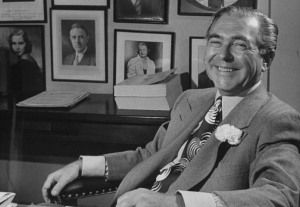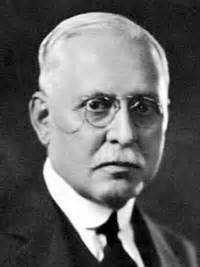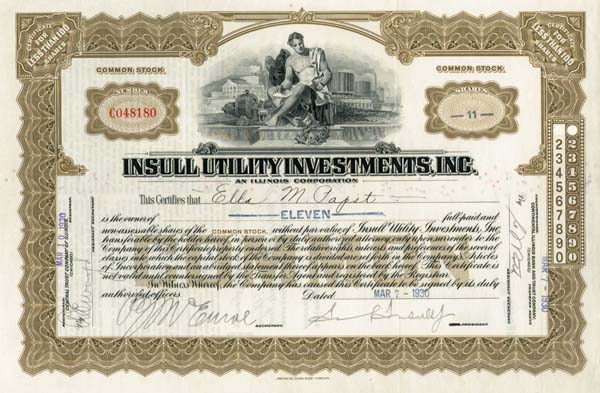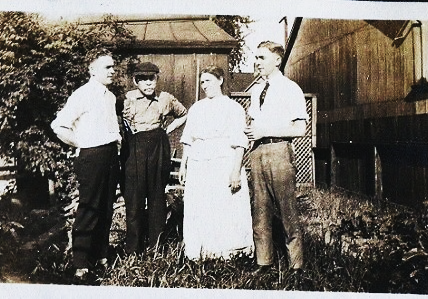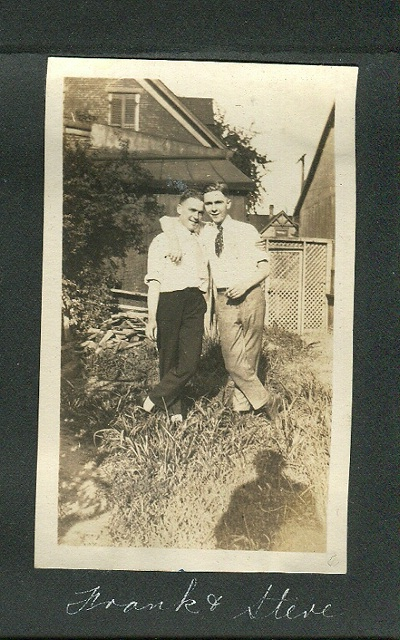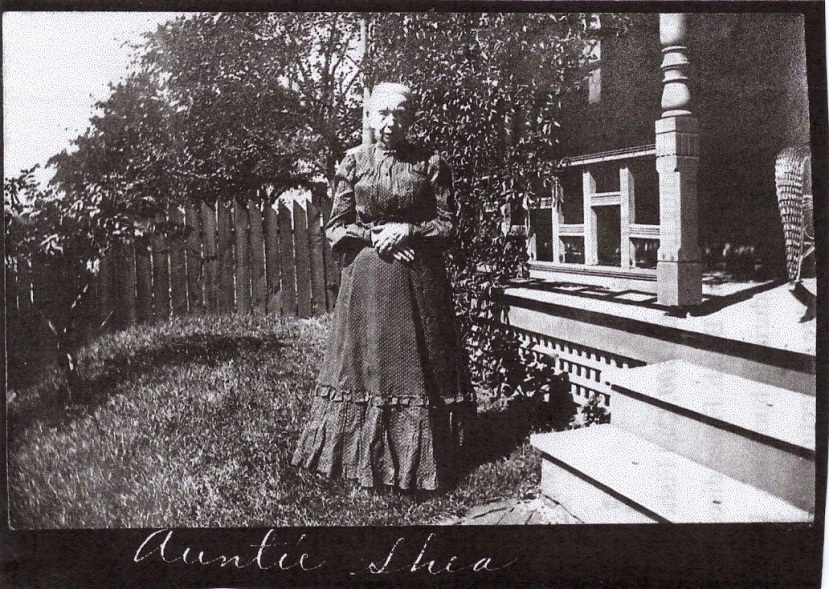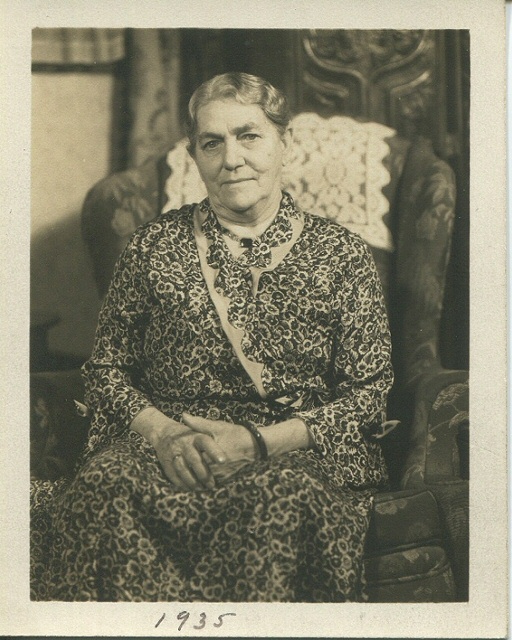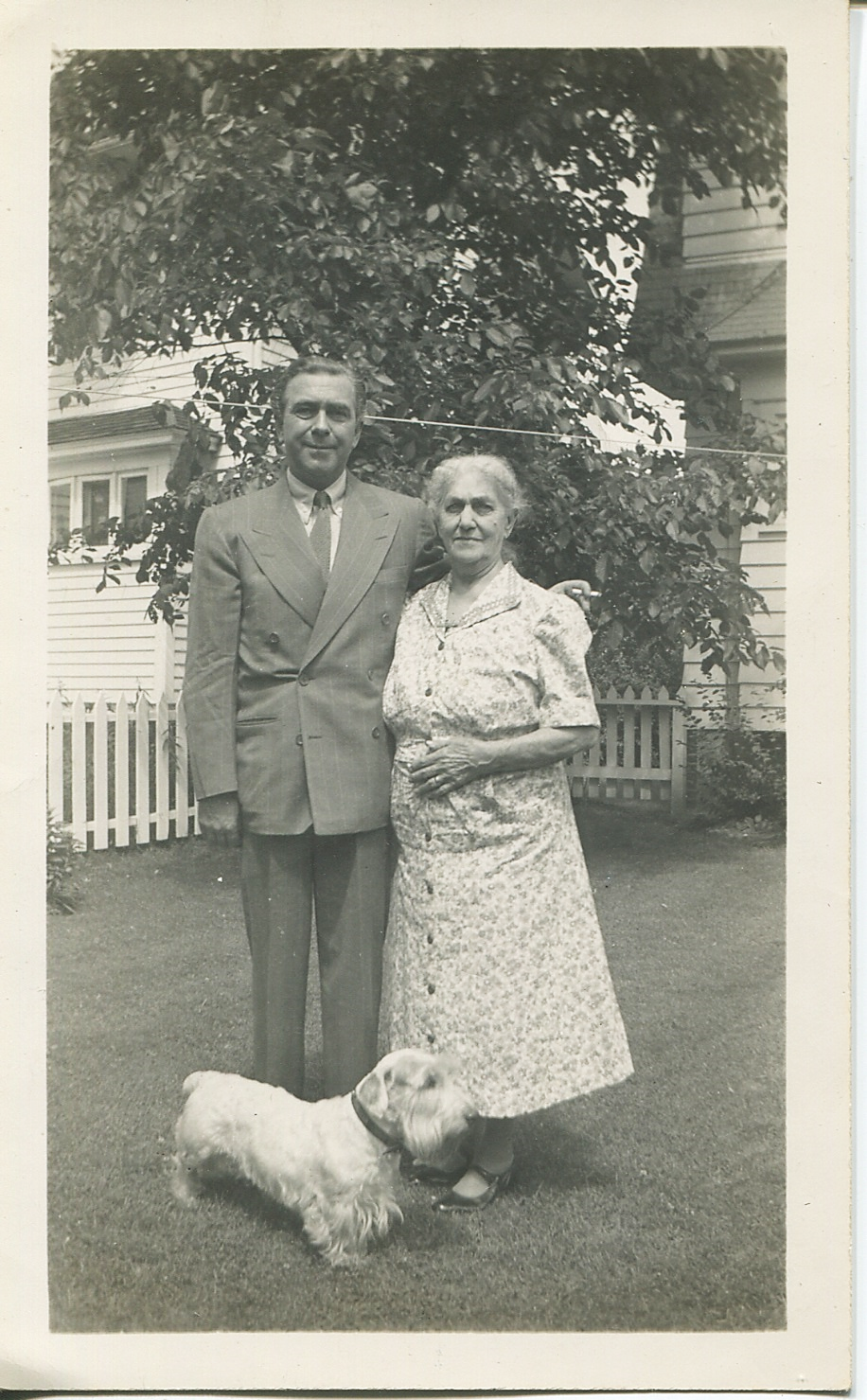Steve Hannagan, the Newsboy
Steve Hannagan first ventured into the news business in high school as a newspaper delivery boy. However, when the sun set on his first day, he dropped his papers, and ran home. Before long he returned to selling newspapers for the Lafayette Journal & Courier, but he wanted to be a reporter. Quickly realizing that the paper’s Managing Editor William Robertson was the key to becoming a reporter, Hannagan approached him. Years later, Robertson said the conversation with Hannagan went something like this:
“’I want to become a reporter.’ ‘How old are you’, asked Robinson? ‘Fourteen! Well, son, I’m afraid that’s a little too young to become a reporter.’ ‘Do you run the paper,’ Steve enquired. ‘No!’ ‘Well, who’s your boss;’ ‘Mr. Henry W. Marshall Owns is Publisher of this paper,’ said Robinson. ‘Where’s his office;’’ Right around the corner!’”[1]
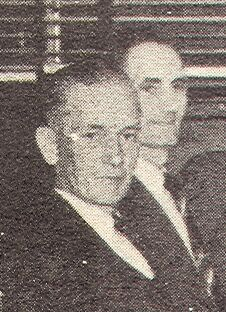
William Robertson[2]
(Foreground of the picture)
Steve Bullies His Way into the Newspaper Owner’s Office
Chaffing at Robertson’s brush-off and propelled by the brashness that would set him apart from his friends, Hannagan marched down to Marshall’s office and informed the secretary that Steve Hannagan was there to see the Publisher. Marshall’s first question was:
“Who are you,” asked Marshall? ‘Steve Hannagan!’ ‘Any relation to Steve Hannagan, who runs the saloon?’ ‘Yes, he’s my uncle.’ ‘Well, what can I do for you?’ … ‘I want to become a reporter.’ The publisher was unimpressed. He told Steve there was no opening for him. ‘All right,’ said Steve, ‘but I’ll be back two days from now at 5 o’clock’”[3]
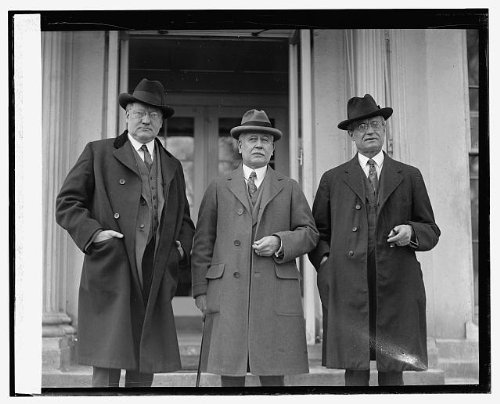
Henry Marshall
(Marshall is in the center of the picture) [4]
Although Marshall also gave Steve the brush-off, he persisted with daily visits to the Publisher’s office. On the thirteenth knock on Marshall’s door, the Publisher said, “Give this boy a job; anything, so he’ll quit pestering me.”[5]
Steve Star Orator at Jefferson High School
Steve juggled being a reporter for the Journal-Courier and being a student at Lafayette’s Jefferson High School. There he saw himself as a mediocre student. Despite his poor showing in most subjects, Steve did have a silver tongue attested by his winning regional and state speech contests.[6] The title of one of his prize winning speeches for which he received a $5 gold piece was “The Power of Conviction,” which asserted that “Conviction … is the result of the mind’s earnest attention on idea.”[7]
Steve developed another skill in high school; he could take a random subject and turn it into a well-written report (much like a news report). Bernard Sobel,[8] his English teacher at Jefferson High, said this about Steve:
“Highest honors in this exercise (extemporaneous report) always went to Steve Hannagan, a smiling sophomore with a knowing look on his Irish rotund face. He met the challenge of this game of words and wit with the same skill, which helped make him, eventually, one of the three or four greatest public relations stars in America.” [9]
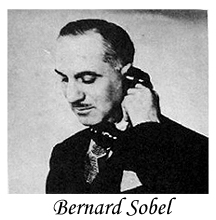
Bernard Sobel[10]
A comment in Steve’s senior yearbook demonstrated his classmates’ belief in his destiny.
“Steve is another of one of our brainy guys, who is gradually… becoming famous as a reporter, at which position he has ample scope to exercise his talent. He has always been a loyal supporter of all school activities and has always had enough self-reliance or conceit … to pull through his studies. We sincerely hope that Steve may be what he thinks himself to be.”[11]
Full-Time Reporter at the Journal & Courier
When Steve enrolled at Purdue University, he joined the Journal & Courier as a full-time reporter, reporting on local high school basketball teams. He happily took on the role as a tout for the mystique of “Hoosier Hysteria.” Where every team no matter how large or small had a chance to win the state title.
Steve at Purdue University
Although Steve was a lackluster student in high school, he was accepted by and attended Purdue University for two years. His experience there was not without its merits as it gave him an opportunity to further develop his journalistic skills.
As a reporter for Journal & Courier interviewed the Hoosier columnist, humorist, folklorist, and playwright, George Ade., who was to be a Purdue commencement speaker.[12] Ade wrote about the “little man “often using the American and Hoosier colloquial vernacular in his narratives.[13] Ade’s favorite remark about life was “to insure peace of mind ignore the rules and regulations,”[14] a saying that might fit well in today’s world.
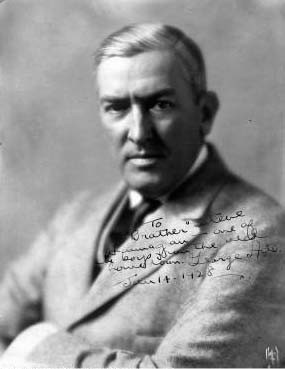
George Ade 1928[15]
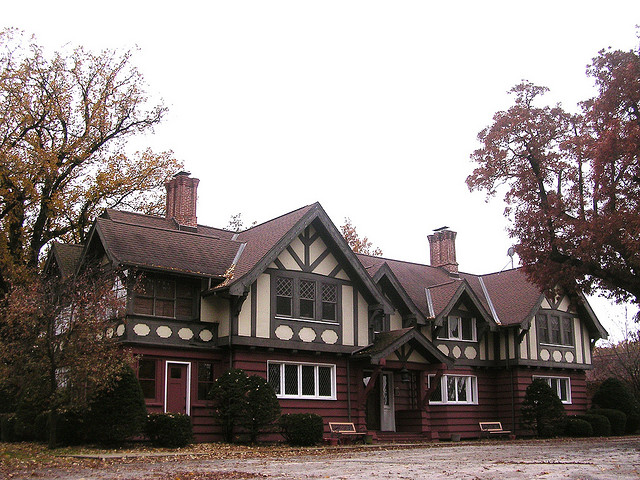
George Ade’s Home in Brook, Indiana[16]
George Ade and Steve eventually became good friends. They corresponded regularly their letters showed mutual admiration for their unique contributions. George Ade introduced Steve to John McCutcheon,[17] who illustrated many of Ade’s books and short stories One of McCutcheon’s illustration was for Ade’s story of the folk legend Injun Summer.[18] Ade’s story was based on a Hoosier folk tale in which corn shocks transformed into teepees and the spirits of Native Americans celebrating their harvest.
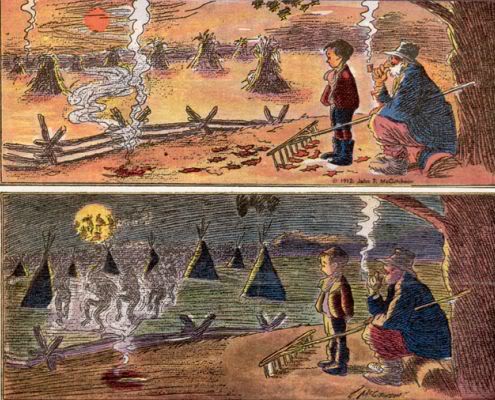
Illustration by John McCutcheon
From George Ade’s Book on Hoosier Folktales[19]
McCutcheon, who founded the Delta Delta chapter of Sigma Chi fraternity at Purdue, encouraged Steve to join the fraternity. Steve joined the fraternity, but he was not much of a fraternity man being more interested in getting ahead in life than being involved in frat parties with campus sororities. In 1948. Sigma Chi named Steve Hannagan a “Significant Sig: for his contribution to his profession as a press agent.
After two years at Purdue, Steve left the University because reporting was more fun than his studies, and he made more at the Journal & Courier than his professor made teaching.
Steve – City Editor at Nineteen
During the last year of World War I, the Journal & Courier lost it City and Sports editors to the army. As a result, Steve was named the Sports Editor and the City Editor at the Journal & Courier. When Steve was named City Editor, his pay grew from a measly $1 a week as a cub reporter to $28.50 a week. In addition, he earned another $25 a week as a stringer for the Indianapolis Star and as a free-lance reporter for other regional newspapers
Hyper Steve
Even while Steve attended high school and later Purdue, he worked around the clock. If he was alive and in school today he would probably be branded as hyperactive. His ability to go full blast for nearly twenty-four hours a day would be an essential ingredient in his life. Few people realize that some successful people often survive with little sleep, and their hyperactivity is a definite advantage because they quickly react to new opportunities. Their fast and furious life style often makes staid mid-level managers uncomfortable.
Contribute Stories to the Blog – We are looking for pictures, comments and stories from our readers about Steve Hannagan. You can submit your stories, etc. to Michael Townsley at: mtown@dca.net. If you know someone who would like to receive the blog, send their name to mtown@dca.net
END NOTES
- Ross, Edward Ellis; Hannagan Research Document; source; New York University Archives; pp. 24 and 25. ↑
- Photograph of William Robertson (Retrieved July 14, 2012); http://images.search.yahoo.com/images/view;_ylt=A0PDoS8LBgFQMmkAfnaJzbkF;_ylu=X3oDMTBlMTQ4cGxyBHNlYwNzcgRzbGsDaW1n?back=http%3A%2F%2Fimages.search.yahoo.com%2Fsearch%2Fimages%3Fp%3DIMAGES%2B%2BLAFAYETTE%2BINDIANA%2B1900S%26n%3D30%26ei%3Dutf-8%26y%3DSearch%26fr%3Dyfp-t-701%26tab%3Dorganic%26ri%3D16&w=226&h=312&imgurl=www.monon.org%2Fpeople2%2F07-L-ThayerWL-RRobinsonBillie.jpg&rurl=http%3A%2F%2Fwww.monon.org%2Fworker6.html&size=28.1+KB&name=Robinson+William+G+Lafayette%2C+Indiana+Died+09-5-1964.&p=IMAGES++LAFAYETTE+INDIANA+1900S&oid=449f5301a7692850ade280ef71fa78b3&fr2=&fr=yfp-t-701&tt=Robinson%2BWilliam%2BG%2BLafayette%252C%2BIndiana%2BDied%2B09-5-1964.&b=0&ni=21&no=16&ts=&tab=organic&sigr=1117er2pp&sigb=144u6t3nv&sigi=11ns1jlk3&.crumb=oum7ZQ9AEIY. ↑
- Ross, Edward Ellis; Hannagan Research Document; source; New York University Archives; pp. 24 and 25. ↑
- Photograph of Henry Marshall, owner of the Journal & Courier newspaper (Retrieved July 14, 2012); http://www.amazon.com/Photo-Watson-Henry-Marshall-Wood/dp/B004JTQA0C/ref=pd_rhf_dp_p_t_2. ↑
- Ross, Edward Ellis; Hannagan Research Document; source; New York University Archives; p. 25. ↑
- “Speaking Contest Won by Hannagan” (1916); Lafayette Journal & Courier. ↑
- “Speaking Contest Won by Hannagan” (1916); Lafayette Journal & Courier. ↑
- Photograph of Bernard Sobel (retrieved July 12, 2012); http://looking-for-mabel.webs.com/bernardsobel.htm. ↑
- Sobel, Bernard (1953); Broadway Heartbeat; Hermitage Books; New York; p. 49. ↑
- Looking for Mabel Norman” (Retrieved April 18, 2017); http://looking-for-mabel.webs.com/bernardsobel.htm. ↑
- Ross, Edward Ellis; Hannagan Research Document; source; New York University Archives; p. 23. ↑
- Ross, Edward Ellis; Hannagan Research Document, source; New York University Archives; p. 26. ↑
- “George Ade” (Retrieved June 5, 2012); http://www.focusdep.com/biographies/George/Ade; p. 1. ↑
- “George Ade” (Retrieved June 5 2012); http://www.imdb.com/name/nm0011748/bio; p. 2. ↑
- Photograph of George Ade (Retrieved June 5 ,2012); http://images.search.yahoo.com/images/view;_ylt=A0PDoQzxtc5P0T0AUuKJzbkF;_ylu=X3oDMTBlMTQ4cGxyBHNlYwNzcgRzbGsDaW1n?back=http%3A%2F%2Fimages.search.yahoo.com%2Fsearch%2Fimages%3F_adv_prop%3Dimage%26va%3Dgeorge%2Bade%26fr%3Dyfp-t-701%26tab%3Dorganic%26ri%3D2&w=345&h=450&imgurl=www.antiimperialist.com%2Fwebroot%2FPEOPLEdocuments%2FMembership%2FPictures%2FGAde.jpg&rurl=http%3A%2F%2Fwww.antiimperialist.com%2Fwebroot%2FPEOPLEdocuments%2FMembership%2FLiterature.html&size=26.1+KB&name=George+Ade&p=george+ade&oid=95936dcf92f7fb1c57a40d08ebe54250&fr2=&fr=yfp-t-701&tt=George%2BAde&b=0&ni=21&no=2&ts=&tab=organic&sigr=12hnkebu5&sigb=138k0g16c&sigi=12cbhiepq&.crumb=IYAF8NqUPhh. ↑
- Photograph of George Ade’s home in Brook, Indiana (Retrieved July 14, 2012); http://images.search.yahoo.com/images/view;_ylt=A0PDoVxTEwFQ_ngA1fSJzbkF;_ylu=X3oDMTBlMTQ4cGxyBHNlYwNzcgRzbGsDaW1n?back=http%3A%2F%2Fimages.search.yahoo.com%2Fsearch%2Fimages%3Fp%3Dbrook%2Bindiana%26_adv_prop%3Dimage%26va%3Dbrook%2Bindiana%26fr%3Dyfp-t-701%26tab%3Dorganic%26ri%3D225&w=640&h=480&imgurl=farm3.staticflickr.com%2F2470%2F4039063433_1cdfa331d6_z.jpg&rurl=http%3A%2F%2Fwww.flickr.com%2Fphotos%2Fshushmuckle%2F4039063433%2F&size=145.1+KB&name=Brook%2C+Indiana&p=brook+indiana&oid=957fc3cf74bea1fc36e7a3c6ebc6a131&fr2=&fr=yfp-t-701&tt=Brook%252C%2BIndiana&b=211&ni=112&no=225&ts=&tab=organic&sigr=11kib7ibg&sigb=13tiipvnj&sigi=11nmhlfeb&.crumb=oum7ZQ9AEIY. ↑
- Rosa, Julia (Retrieved June 5, 2012); “John McCutcheon Encounters Lifetime of Adventure after Purdue Years;” Purdue News; http://news.uns.purdue.edu/html3month/McCutcheon.lifetime.html. ↑
- McCutcheon, John T. (September 30, 1907); “Injun Summer;” Chicago Tribune; http://www.tkinter.smig.net/Chicago/InjunSummer/index.htm. ↑
- McCutcheon, John T. (September 30, 1907) “Injun Summer;” Chicago Tribune; http://www.tkinter.smig.net/Chicago/InjunSummer/index.htm. ↑
